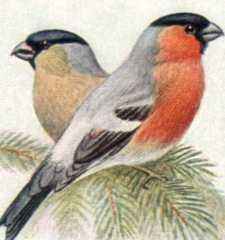|
Bullfinches |

Eurasian bullfinch (male and female)
|
|
Scientific classification |
|
|
| Species |
|
See text. |
Pyrrhula is a small genus of
passerine birds, commonly called Bullfinches,
belonging to the finch family (Fringillidae).
The genus has a palearctic distribution. All species
occur in Asia with two species exclusively in the Himalayas and one species, P. pyrrhula, also
occurring in Europe. The Azores Bullfinch (P. murina)
is an almost extinct species (about 120 pairs remaining),
occurring only in the east of the island of
São Miguel.
Analysis of the
mtDNA cytochrome b sequence indicates that the holarctic
Pine Grosbeak (Pinicola enucleator) is the closest living
relative of this genus. Arguably, it could be included in
Pyrrhula, but more probably is a distinct offshoot of a
common ancestor, with the Pine Grosbeak as the sister group
to the ancestor of the bullfinches (Arnaiz-Villena et al.,
2001). The evolution of the bullfinch species started soon
after the Pine Grosbeak's ancestors diverged from them (at
the end of the Middle Miocene, about a dozen mya), and it is
quite possible that the latter species evolved in North
America; waht is fairly certain is that the bullfinch
radiation started in the general area of the Himalayas. The
mountain finches also seem to be part of this clade (Marten & Johnson, 1986).
Bullfinches have glossy black wings and tail feathers.
They show a white rump. The legs and feet are fleshy brown.
Their short, swollen bill is adapted to eat buds, and is
black except in P. nipalensis, which has a yellowish
bill. The males can be distinguished by their orange or red
breast. Some species have a black cap.
Bullfinch species are sedentary to migratory; probably
most populations are partially migratory. Populations winter
chiefly within the breeding range, those breeding at high
levels tending to make altitudinal movements. Most migrants
move short or medium distances, but some (apparently chiefly
from Russia) move longer distances; in northern and central
Europe, there is no evidence that northern populations move
further than southern ones. North European birds move within
a wider compass than central European birds. Bullfinshes are
also eruptive migrants; numbers migrating show marked annual
fluctuations; no link with particular food source has been
established. Autumn migration begins late, and is fairly
brief, mostly October-November; spring migration
February-April.
The Eurasian Bullfinch population in Britain has been in
serious decline since the mid-1970s, following a period of
relative stability, and numbers have fallen by 62 per cent
in 35 years. The decline was initially rapid, but has been
shallower since the early 1980s. Nevertheless, the
CES and BBS both suggest that the decline is continuing, at
least in southern Britain. The demographic mechanism remains
unclear (Siriwardena et al. 1999, 2000b), although
agricultural intensification is suspected to have played a
part. CES data indicate that productivity has increased over
the last decade, and nest failure rates at the chick stage
(15 days) have fallen from 37% to 21%.
Species
- Pyrrhula aurantiaca Gould, 1858: Orange Bullfinch
(Range : Kashmir)
Pyrrhula erythaca Blyth, 1862: Grey-headed Bullfinch
(Range : Western China, Tibet)
Pyrrhula erythrocephala Vigors, 1832: Red-headed
Bullfinch (Range: Himalayas)
Pyrrhula leucogenis Ogilvie-Grant, 1895: White-cheeked
Bullfinch (Range : Philippines)
Pyrrhula murina du Cane Godman, 1866: Azores Bullfinch
(Range : São Miguel Island, Azores)
Pyrrhula nipalensis Hodgson, 1836: Brown Bullfinch
(Range : Himalayas, northern Myanmar and Northwest
Yunnan)
Pyrrhula pyrrhula (Linnaeus, 1758): Eurasian Bullfinch
(Range : very wide, from Asia to Europe)
Genus Pyrrhula should be considered to be included in
Genus Carduelis.Redpolls and Crossbills are the closest
extant relatives (Arnaiz-Villena et al,58:1159,2001)
References
- Arnaiz-Villena, A.; Guillén, J.;
Ruiz-del-Valle, V.; Lowy, E.; Zamora, J.; Varela, P.;
Stefani, D. & Allende, L. M. (2001): Phylogeography of
crossbills, bullfinches, grosbeaks, and rosefinches.
Cellular and Molecular Life Sciences 58:
1159–1166.
PDF fulltext
- Marten, Jill A. & Johnson, Ned K.
(1986): Genetic relationships of North American
cardueline finches.
Condor 88(4): 409-420.
PDF fulltext




